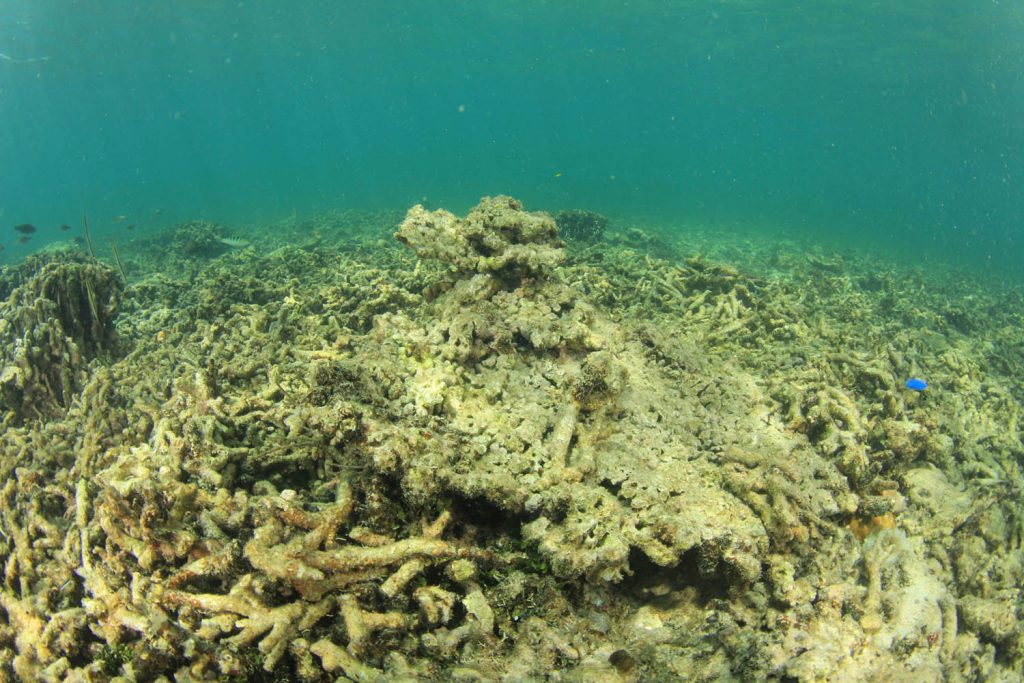The Caribbean owes its very existence to coral reefs. The beautiful white sand on the beaches many Caribbean countries are famous for comes from bits of coral skeleton being consumed then excreted by parrotfish (the species gets its name from its hard, beak-shaped mouth). One parrotfish can excrete up to 2,000 pounds of sand a year. And the reefs themselves are also a tourist draw, providing popular scuba diving, snorkelling, or glass-bottom boat experiences.
Corals — tiny animals called polyps that bunch together into various colours, shapes and sizes — provide a nursery, home, and sustenance to many weird and wonderful species of sea life, which add to the reefs’ beauty.
Some species — like the parrotfish, grouper, snapper, lobsters, and conch — are important to the livelihood of fisherfolk. And reefs also protect the coasts and the human structures there from harsh wave action during hurricanes (and year-round).
Climate change; overfishing of species valuable to reefs; and pollution have brought the region shockingly close to losing this vital resource. Coral bleaching — when stresses cause them to lose their colour — and diseases are destroying large swaths of reefs in the Caribbean and other parts of the world.
The International Union for the Conservation of Nature (IUCN) has designated Caribbean coral reefs as endangered on its Red List of Ecosystems.
“The Caribbean has been hit pretty hard,” said Simon Dixon, aquaculture operations manager with the Bahamas-based Coral Vita, one of the many organisations working to preserve and restore reefs in the region.
Dixon, who’s done the same work elsewhere in the world, told Caribbean Beat during a Zoom interview: “I think the one thing that does set the Caribbean apart is the sheer volume of people that really care. The [number] of people pulling together to try and make a difference in this region alone is enough to give everybody hope.”
Last July, the BBC’s The Climate Question podcast highlighted the work of the Institute of Socio-Ecological Research across various parts of Puerto Rico — among the most successful and well-known reef restoration efforts in the Caribbean.
In Belize, the organisation Fragments of Hope say they’ve increased coral cover at Laughing Bird Caye National Park by 50% since they began operating there in 2009. They’re now working on reefs in three other reserves in the country.
The Nature Conservancy — the United States-based NGO that spearheads environmental projects around the world — launched CoralCarib in 2023 to restore reefs in Cuba, Jamaica, Haiti, and the Dominican Republic. These countries combined account for most of the reefs in the Caribbean.
Coral Vita may be the most ambitious project. Started in 2019 on Grand Bahama by Yale grads Sam Teicher and Gator Halpern, it won Prince William’s prestigious Earthshot prize when the prize was launched in 2021. The award, which comes with £1 million, recognises organisations and individuals who come up with innovative ways to work on environmental problems.
Coral Vita uses restoration best practices like micro-fragmentation, which involves slicing coral into small pieces and placing them close to each other on a disc. This encourages them to grow towards each other and fuse — a process that would have taken far longer under natural conditions.
They also practise what is called assisted evolution — subjecting the corals to increasing temperatures, therefore helping them become more resilient to those temperatures. The corals are kept on a “farm” in tanks filled with sea water. When they reach a certain size, they are transplanted to the reef that is being restored.
Ultimately, the only way to save coral reefs is to rein in climate change and other human-related problems affecting the reef. Restoration alone won’t be enough
Coral Vita also uses corals’ ability to spawn to reproduce them in the lab — again, at a faster rate than in the wild.
But what really sets Coral Vita apart are their commercial ambitions. They want to restore coral on a massive scale, and they believe the only way to do that is to make restoration a business enterprise. This will draw more talent and resources to the field.
“If you really want to make progress in this industry, this is a sort of direction that has the ability to really make a difference on a global scale,” said Dixon.
Coral Vita earned a contract in Saudi Arabia to help create what would be the largest land-based coral farm in the world. Coral Vita Chief Operating Officer Austin Martin explained the Saudi Arabia project at the Vodex World’s Top 50 Innovators event in London last year.
“The vision the king has had there is to modernise by 2030, which has led to some of the world’s biggest infrastructure projects — the giga-projects,” said Martin. “With that comes potential damage for the reef ecosystem. So, we’re there prophylactically, being able to anticipate that and actually protect the coral ecosystems that are already there.”
Martin said US$18 billion from various sources is already committed to reef restoration projects around the world. But the field has the market potential for another US$500 billion. “We just have to think differently,” he said. “Thinking differently is really what sets Coral Vita apart.”
The company is looking for other projects like that of Saudi Arabia. “We’re looking at leveraging this sort of restoration, becoming a part of governmental policy the world over,” said Dixon. “When we’re building ports, when we’re developing for cruise ships, when we’re establishing hotels or residential areas close to the ocean, close to the beach. If we’re doing anything around the ocean or indeed around the coastline, we want to be a part of that conversation.”
Back in the Caribbean, Coral Vita is exploring opportunities in Barbados. They’re doing the same in Florida, the Maldives, and Mexico. They have another Coral Vita operation in Dubai.
Giving a talk last year, founder Sam Teicher announced that Coral Vita qualified for Series A financing, which opens the company up to receiving many millions of dollars from investors. To qualify, a company must demonstrate that their product or service is viable. “It would be the first Series A for a coral restoration company, to my knowledge,” said Teicher.
Other ways Coral Vita makes money include offering tours of the farm for a fee, and operating a gift shop and cafe on the compound. People can also “adopt” a coral to help fund restoration.
As part of a deal between Coral Vita and Corona, the beer company is sponsoring a patch of reef in Grand Bahama that needs restoration. Corona is encouraging donations that they’ve pledged to match. In exchange, donors will have their names engraved on a plinth to be placed on the restoration site.
Despite all these efforts, ultimately the only way to save coral reefs in the Caribbean and other parts of the world is to rein in climate change and other human-related problems affecting the reef. Restoration won’t be enough.
“It’s better to do something than nothing. And right now, we need to do something until we find the answer,” said Dixon. “This is a snowballing problem, which is causing us a lot of issues the world over,” he said of coral reef decimation. “If we can do our small part to try and remedy some of this through our restoration efforts, then that’s something I’m incredibly proud of.”

